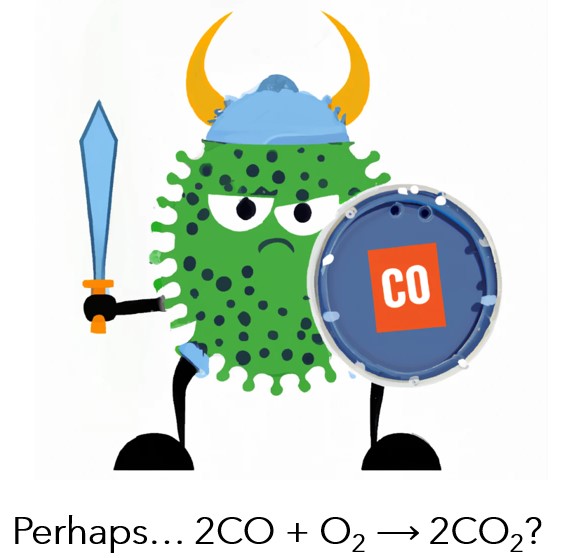Cite as: Spacek, J. (2023) “Evolution is cleverer than you are”. Primordial Scoop, e20231117. https://doi.org/10.52400/WYVX2696
In the last two post (NASA still wrong, Martians at night) Steven Benner presented a hypothesis that Viking found autotrophic life. Steven postulates that this life would generate molecular oxygen (O2) as a byproduct of photosynthetic or chemosynthetic carbon dioxide (CO2) reduction. Martians would store the O2 generated during the day to use it for aerobic oxidation (respiration) to produce energy at night. Before I address flaws in his hypothesis, let me first list the where I agree with Steven:
- Viking results has not yet been satisfactorily explained. Although there are publications claiming to do so,1-4 they do not withstand scrutiny.
- NASA’s astrobiology community erroneously assumes that Viking results have been explained with abiotic chemistry.
- NASA’s astrobiology community erroneously assumes that Viking presented negative results.
- Someone should pick up the torch and search for life on Mars.
Now for the flaws:
Steve approaches the problem of Martian biology from the first principles using his extensive knowledge of chemistry to search for answers. I could not do such analysis as my understanding of chemistry is too limited. But my study of biology has thought me over and over that I should follow Orgel’s Second Rule referred in the title of this article: “Evolution is cleverer than you are.”
I believe that microbes understand chemistry better than expert chemists.
For example, Steven assumes that photosynthesis is the best way to generate energy in the dry and cold Martian soils. But bacteria living in high arctic dry and cold soils generates virtually all of the local biomass without photosynthesis although it would be much more efficient in arctic than on Mars. Earth’s dry arctic soil microbes almost exclusively rely on energy extracted from aerobic oxidation of atmospheric H2 (11 ppb) and CO (500 ppb).5 Interestingly H2 oxidation is also the only source of water that these microbes require.
Steven also tells us that “The [Martian] microbes make reduced carbon biomass by using energy to fix CO2 to give reduced carbon (Creduced) … That process must generate O2; this conclusion is unavoidable after one balances the chemical equation.” (emphasis added)
But when you examine Earth’s anaerobic autotrophic bacteria, your will find that carbon fixation rarely involves O2 generation. To reduce CO2 anaerobic autotrophs on Earth typically oxidize hydrogen sulfide or elemental sulfur6 to sulfate, or ammonia to N2.7 We can argue that these substrates might be rare in Mars. Well, on Earth we have electrolithoautotrophs that reduce CO2 and oxidize iron (usually Fe2+ to Fe3+).8, 9 We know that ferrous hydroxy minerals are present in the Martian soil.10 Arguably rust generation in the Martian dry environment might not be the best strategy, but this is just to show that O2 generation to reduce CO2 is not “unavoidable.”
For energy generation Steven proposes aerobic respiration using the stored O2. Strategies of microbes we know suggests that anaerobic carbon monoxide (CO) metabolism11 might be a better option to strategy proposed by Steven.
Sulfate reducing, CO oxidizing bacteria generate energy following this pathway11:
4CO + SO42- + H+⟶ 4CO2+ HS– + energy
Sulfate reduction is also used by sulfate reducer Desulfotomaculum kuznetsovii, but when we do not provide sulfates, it can extract energy directly from CO and water:
CO + H2O ⟶ CO2 + H2 + energy
What’s more D. kuznetsovii and several other microbes were shown to use CO as its sole source of carbon to generate its biomass, while growing in 100 % CO atmosphere.12
We can also find anerobic extreme halophiles living in perchlorate brines. They generate energy via oxidation of CO and reduction of perchlorate and chlorate:13, 14
CO + ClO4– ⟶ CO2 + ClO3– + energy
CO + ClO3– ⟶ CO2 + ClO2– + energy
Knowing that 0.5 ppm of CO is sufficient to sustain life in arctic desert at Earth atmosphere pressure (~1000 millibars),5 on Mars 700 ppm of CO and 10000 ppm of H2O at total of 6 millibars might be enough to sustain metabolism similar to methanogenic anaerobobes:11
4CO + 2H2O ⟶ CH4 + 3CO2 + energy
Finally, even if Martians did prefer photosynthesis unlike the bacteria we have in arctic soils, Steven still should have avoided the “must.” Most of the photosynthetic anaerobes on Earth are anoxygenic. That means that they do not generate O2 as photosynthesis biproduct.15
I do not know why arctic soil bacteria prefers trace gas metabolism over photosynthesis or why bacteria living in anaerobic environment typically avoid generation of O2. I just believe that these critters know something Steven overlooked. I do not believe that Martians “must” generate and store oxygen and respire at night.
One last nitpick. Steven said that “Martians cannot obtain O2 from the atmosphere to serve as a bio-oxidant for later respiration.” Martian atmosphere has 1700 ppm of O2. Trace gas metabolism5 in combination with aerobic respiration in apparently anoxic environment16 indicate that Martians might have plenty of oxygen for aerobic oxidation of CO without the need for O2 storage:
2CO + O2 ⟶ 2CO2 + a lot of energy
Steven told me that his hypothesis of oxygen generation, storage and usage by Martians explains Viking results, while me pointing out flaws in his hypothesis does not. I must admit that this is an accurate assessment. Here I am not trying to make a story to fit any narrative. I’m just pointing out flaws in Steven’s story.
I want to find the explanation of the results observed by Viking probes. As Steven in detail described in his last two posts, we still do not know what caused the oxygen release or partial inactivation of the oxidizing agent by heating to 46 °C or almost complete inactivation of the oxidant by storage at ~10 °C for 84 sols.17
However, the problem with biology is that it is very hard to predict and yet easy to bend to fit any narrative. Here I presented many alternative pathways life on Mars might use.
As Steven pointed out: “…one can readily generate a biological model for all of these results.” And if you run into any tight spot with your model, you can always pull-out Steven’s favorite quote: “Life, uh, finds a way” – the story writes itself!
Steven’s explanations might be correct, although Terran extremophiles indicate they are not. Until we send an improved experiments to Mars, such as a chiral labeled release experiment or ALF18, we will not be sure.
An explanation without an experiment is doomed to remain merely a story, regardless of how confidently it is being told.
References
(1) Biemann, K.; Bada, J. L. Comment on “Reanalysis of the Viking results suggests perchlorate and organics at midlatitudes on Mars” by Rafael Navarro-González et al. Journal of Geophysical Research 2011, 116 (E12), 12001-12001. DOI: 10.1029/2011je003869.
(2) Navarro-González, R.; McKay, C. P. Reply to comment by Biemann and Bada on “Reanalysis of the Viking results suggests perchlorate and organics at midlatitudes on Mars”. Journal of Geophysical Research: Planets 2011, 116 (E12), 12002-12002. DOI: 10.1029/2011JE003880.
(3) Navarro-González, R.; Vargas, E.; De La Rosa, J.; Raga, A. C.; McKay, C. P. Reanalysis of the Viking results suggests perchlorate and organics at midlatitudes on Mars. Journal of Geophysical Research E: Planets 2010, 115 (12), 12010-12010. DOI: 10.1029/2010JE003599.
(4) Quinn, R. C.; Martucci, H. F.; Miller, S. R.; Bryson, C. E.; Grunthaner, F. J.; Grunthaner, P. J. Perchlorate radiolysis on Mars and the origin of martian soil reactivity. Astrobiology 2013, 13 (6), 515-520.
(5) Greening, C.; Grinter, R. Microbial oxidation of atmospheric trace gases. Nature Reviews Microbiology 2022, 20 (9), 513-528.
(6) Friedrich, C. G.; Bardischewsky, F.; Rother, D.; Quentmeier, A.; Fischer, J. Prokaryotic sulfur oxidation. Current opinion in microbiology 2005, 8 (3), 253-259.
(7) Kuenen, J. G. Anammox bacteria: from discovery to application. Nature Reviews Microbiology 2008, 6 (4), 320-326.
(8) Emerson, D.; Fleming, E. J.; McBeth, J. M. Iron-oxidizing bacteria: an environmental and genomic perspective. Annual review of microbiology 2010, 64, 561-583.
(9) Hedrich, S.; Schlömann, M.; Johnson, D. B. The iron-oxidizing proteobacteria. Microbiology 2011, 157 (6), 1551-1564.
(10) Bell III, J. F.; McCord, T. B.; Owensby, P. D. Observational evidence of crystalline iron oxides on Mars. Journal of Geophysical Research: Solid Earth 1990, 95 (B9), 14447-14461.
(11) Oelgeschläger, E.; Rother, M. Carbon monoxide-dependent energy metabolism in anaerobic bacteria and archaea. Archives of microbiology 2008, 190, 257-269.
(12) Parshina, S. N.; Sipma, J.; Nakashimada, Y.; Henstra, A. M.; Smidt, H.; Lysenko, A. M.; Lens, P. N.; Lettinga, G.; Stams, A. J. Desulfotomaculum carboxydivorans sp. nov., a novel sulfate-reducing bacterium capable of growth at 100% CO. International Journal of Systematic and Evolutionary Microbiology 2005, 55 (5), 2159-2165.
(13) Myers, M. R.; King, G. M. Perchlorate-coupled carbon monoxide (CO) oxidation: evidence for a plausible microbe-mediated reaction in Martian brines. Frontiers in microbiology 2017, 8, 2571.
(14) Myers, M. R.; King, G. M. Addendum: Perchlorate-coupled carbon monoxide (CO) oxidation: Evidence for a plausible microbe-mediated reaction in Martian brines. Frontiers in Microbiology 2019, 10, 1158.
(15) George, D. M.; Vincent, A. S.; Mackey, H. R. An overview of anoxygenic phototrophic bacteria and their applications in environmental biotechnology for sustainable Resource recovery. Biotechnology reports 2020, 28, e00563.
(16) Berg, J. S.; Ahmerkamp, S.; Pjevac, P.; Hausmann, B.; Milucka, J.; Kuypers, M. M. How low can they go? Aerobic respiration by microorganisms under apparent anoxia. FEMS Microbiology Reviews 2022, 46 (3), fuac006.
(17) Levin, G. V.; Straat, P. A. The case for extant life on Mars and its possible detection by the Viking labeled release experiment. Astrobiology 2016, 16 (10), 798-810.
(18) Špaček, J.; Benner, S. A. Agnostic Life Finder (ALF) for Large-Scale Screening of Martian Life During In Situ Refueling. Astrobiology 2022, 22 (10), 1255-1263.



